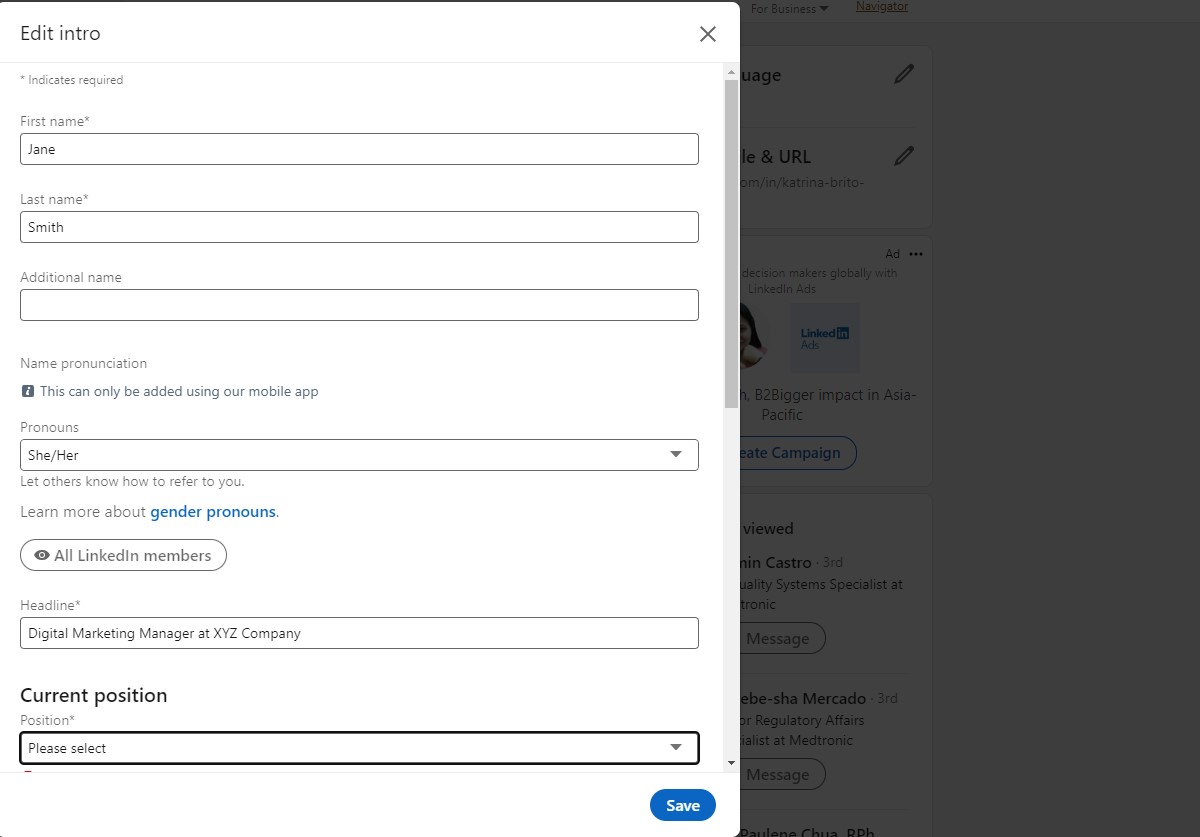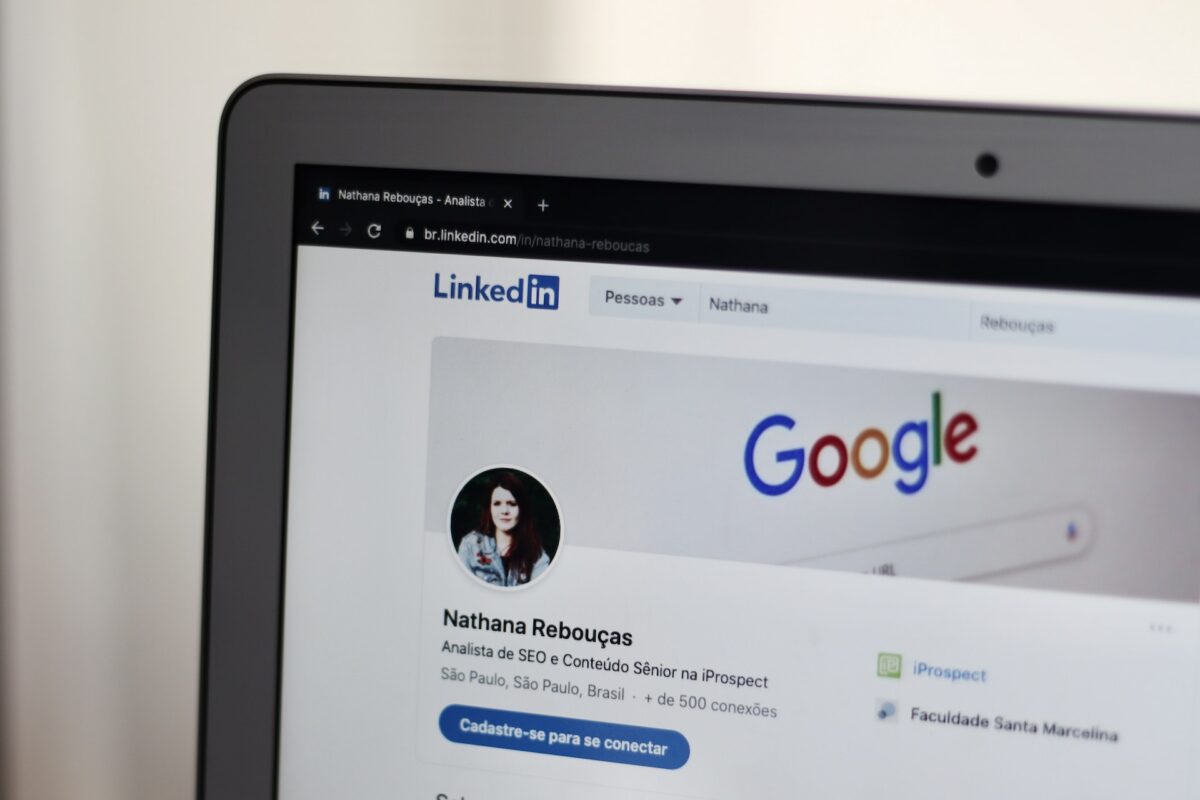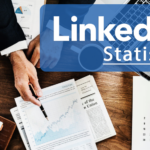What to put in LinkedIn headline?
Your LinkedIn headline is one of the most important aspects of your profile.
It’s the first thing people see when they search for you on LinkedIn, and it’s the first impression you make on potential employers and connections.
Your headline should be a brief, one-line summary of who you are, what you do, and what you bring to the table.
The key to a great LinkedIn headline is to be specific and concise.
You want to make sure that your headline accurately reflects your professional brand and highlights your unique skills and experience.
Avoid using vague or generic terms like “experienced professional” or “results-driven leader.”
Instead, use specific job titles or descriptive phrases that showcase your expertise and accomplishments.
Your LinkedIn headline is also a great opportunity to stand out from the crowd.
You can use humor, creativity, or a unique selling proposition to make your headline more memorable and engaging.
Just make sure that your headline is still professional and relevant to your career goals.
In this article, we’ll provide you with some tips and examples to help you craft a LinkedIn headline that gets noticed and sets you apart from the competition.
Post Contents
Understanding the Importance of LinkedIn Headline
Your LinkedIn headline is one of the most important parts of your LinkedIn profile.
It is the first thing people see when they come across your profile, and it can make or break their first impression of you.
Your headline is your chance to make a great first impression and to show people what you are all about.
Your LinkedIn headline is also important because it affects your visibility on the platform.
LinkedIn’s search algorithm uses your headline to determine how relevant your profile is to a particular search query.
This means that if your headline is well-written and includes relevant keywords, you are more likely to appear in LinkedIn searches.
Your headline is also important because it can help you stand out from the crowd.
There are millions of people on LinkedIn, and many of them have similar backgrounds and qualifications to yours.
Your headline is your chance to differentiate yourself and to show people what makes you unique.
When writing your LinkedIn headline, it is important to be clear and concise.
You only have 220 characters to work with, so you need to make every word count.
Your headline should clearly communicate what you do and what you are passionate about.
It should also include relevant keywords that will help you appear in LinkedIn searches.
What to Put in LinkedIn Headline?

Your LinkedIn headline is the first thing that people see when they come across your profile.
It is a brief introduction to who you are and what you do.
Therefore, it is essential to make it count.
Here are some tips on what to put in your LinkedIn headline to make it stand out.
Your Current Position and Company
Your current position and company should be the first thing you include in your LinkedIn headline.
This information helps people understand your current role and where you work.
For example, “Marketing Manager at XYZ Company” is a simple and effective way to convey your position and company.
Your Area of Expertise
Your area of expertise is another crucial element to include in your LinkedIn headline.
This information helps people understand what you do and what you are good at.
For example, “Digital Marketing Strategist” or “Software Developer” are specific and concise ways to convey your area of expertise.
Your Value Proposition
Your value proposition is what sets you apart from others in your field.
It is a brief statement that highlights your unique skills and experience.
For example, “Transforming businesses through innovative marketing strategies” or “Creating software solutions that streamline business operations” are great examples of value propositions.
Certifications and Achievements
Including certifications and achievements in your LinkedIn headline can help you stand out from the crowd.
It demonstrates your expertise and shows that you are committed to your profession.
For example, “Certified Project Manager with PMP” or “Award-winning Graphic Designer” are excellent ways to showcase your accomplishments.
Optimizing Your LinkedIn Headline for Search
Your LinkedIn headline is the first thing that people see when they search for you on LinkedIn.
Therefore, it is essential to optimize your LinkedIn headline to make it more visible to your target audience.
Here are some tips to help you optimize your LinkedIn headline for search.
Using Relevant Keywords
One of the best ways to optimize your LinkedIn headline for search is to use relevant keywords.
Keywords are the words or phrases that people use when they search for something on LinkedIn.
By using relevant keywords in your LinkedIn headline, you increase the chances of your profile appearing in the search results.
To find relevant keywords, you can use LinkedIn’s search results to see what other people in your industry are using in their headlines.
You can also use LinkedIn’s optimization tool to find keywords that are relevant to your industry and job title.
Staying within Character Limit
LinkedIn allows you to use up to 220 characters in your headline.
It is essential to stay within this character limit to ensure that your entire headline is visible in the search results.
If your headline is too long, it will get cut off, and people will not be able to read the entire headline.
To stay within the character limit, you can use bullet points or symbols to convey your message more succinctly.
You can also use abbreviations or acronyms to save space.
By optimizing your LinkedIn headline for search, you increase the chances of your profile appearing in the search results.
Use relevant keywords and stay within the character limit to make your headline more visible to your target audience.
Common Mistakes to Avoid

When it comes to your LinkedIn headline, there are some common mistakes you should avoid.
Here are a few you should be aware of:
Using Generic Job Titles
One of the biggest mistakes you can make with your LinkedIn headline is using a generic job title.
For example, if you’re a software engineer, don’t just use “Software Engineer” as your headline.
Instead, try to be more specific about your skills and experience.
You could use something like “Full-Stack Software Engineer with Expertise in React and Node.js”.
This will help you stand out from others with similar job titles and make it clear what you bring to the table.
Ignoring the Audience
Another mistake is ignoring your audience.
Your LinkedIn headline is one of the first things people will see when they come across your profile, so it’s important to make sure it speaks to them.
Consider who your target audience is and what they’re looking for.
Are they potential clients, employers, or industry peers?
Tailor your headline to their needs and interests.
Overuse of Emojis
While emojis can be a fun way to add personality to your LinkedIn headline, be careful not to overdo it.
Using too many emojis can make your headline look unprofessional and distract from the message you’re trying to convey.
Stick to one or two relevant emojis, if any, and make sure they enhance your headline rather than detract from it.
By avoiding these common mistakes, you can create a LinkedIn headline that stands out and speaks directly to your target audience.
Remember to be specific about your skills and experience, consider your audience, and use emojis sparingly.
Tailoring LinkedIn Headline for Different Audiences
As a professional on LinkedIn, your headline is one of the most important parts of your profile.
It is the first thing that people see when they come across your profile, and it can make or break their decision to connect with you or learn more about what you have to offer.
The key to creating a great LinkedIn headline is to tailor it to your specific audience.
Here are some tips for crafting the perfect LinkedIn headline for different audiences.
Job Seekers
If you are a job seeker, your LinkedIn headline should be focused on your skills and experience.
Use keywords that are relevant to the job you are looking for, and highlight your most impressive accomplishments.
You want to make sure that your headline stands out from the crowd and catches the attention of recruiters and hiring managers.
Here are some examples of effective LinkedIn headlines for job seekers:
- Experienced Marketing Manager Seeking New Opportunities
- Award-Winning Sales Professional with a Proven Track Record
- Skilled Software Developer Looking for Next Challenge
Students
If you are a student, your LinkedIn headline should be focused on your education and career goals.
Use keywords that are relevant to your field of study, and highlight any internships or extracurricular activities that demonstrate your skills and experience.
You want to make sure that your headline shows that you are serious about your career and are actively seeking opportunities to learn and grow.
Here are some examples of effective LinkedIn headlines for students:
- Aspiring Marketing Professional with a Passion for Social Media
- Computer Science Student with a Strong Background in Programming
- Recent Graduate Seeking Entry-Level Position in Finance
Entrepreneurs
If you are an entrepreneur, your LinkedIn headline should be focused on your business and your unique value proposition.
Use keywords that are relevant to your industry, and highlight any awards or recognition that your business has received.
You want to make sure that your headline shows that you are a thought leader in your field and that you have the expertise to help others succeed.
Here are some examples of effective LinkedIn headlines for entrepreneurs:
- Innovative CEO Helping Businesses Grow and Thrive
- Award-Winning Marketing Strategist Driving Results for Clients
- Experienced Consultant Helping Companies Navigate Change
Unemployed Professionals
If you are currently unemployed, your LinkedIn headline should be focused on your skills and experience.
Use keywords that are relevant to the job you are looking for, and highlight any volunteer work or freelance projects that you have completed.
You want to make sure that your headline shows that you are actively seeking new opportunities and are committed to your career.
Here are some examples of effective LinkedIn headlines for unemployed professionals:
- Experienced Project Manager Seeking New Challenges
- Skilled Writer Looking for Freelance Opportunities
- Sales Professional with a Proven Track Record Seeking New Role
Remember, your LinkedIn headline is your chance to make a great first impression.
By tailoring your headline to your specific audience, you can increase your visibility on the platform and attract the right people to your profile.
Use these tips to create a headline that stands out and shows off your unique value proposition.
Examples of Effective LinkedIn Headlines
Your LinkedIn headline is the first thing that people see when they come across your profile.
It’s your chance to make a great first impression and showcase your value.
Here are some examples of effective LinkedIn headlines that you can use as inspiration for your own:
- Marketing Manager at XYZ Company | Driving Growth Through Innovative Strategies
- Software Engineer | Solving Complex Problems with Creative Solutions
- Sales Executive | Helping Companies Achieve Their Revenue Goals
- Human Resources Specialist | Building Strong Teams and Cultivating Talent
- Freelance Writer | Crafting Compelling Stories That Captivate Audiences
- Graphic Designer | Bringing Ideas to Life with Stunning Visuals
- Project Manager | Delivering High-Quality Results On Time and On Budget
- Digital Marketing Strategist | Maximizing ROI with Data-Driven Campaigns
Notice how each of these headlines includes the person’s job title and a brief description of their value proposition.
This helps to immediately communicate what they do and what they bring to the table.
When crafting your own LinkedIn headline, think about what sets you apart from others in your field.
What unique skills or experiences do you have that make you a valuable asset?
Make sure to highlight these in your headline.
Remember, your LinkedIn headline is not the place to be vague or generic.
Use specific language that accurately reflects your expertise and what you have to offer.
By creating a strong LinkedIn headline, you can increase your visibility, attract potential employers or clients, and ultimately achieve your career goals.
Key Takeaways
When it comes to your LinkedIn headline, there are a few key takeaways to keep in mind.
Here are some tips to help you create a headline that will grab attention and make a great impression:
Keep it concise
Your headline is limited to just 220 characters, so it’s important to keep it short and sweet.
Use brief, impactful language to get your point across and make a strong impression on potential employers or clients.
Highlight your expertise
Your headline is a great place to showcase your skills and expertise.
Use keywords and phrases that describe your professional strengths and make it clear what you have to offer.
Be specific
Avoid vague or generic language in your headline.
Instead, be specific about what you do and what makes you stand out.
This will help you attract the right kind of attention from the people you want to connect with.
Use action-oriented language
Action-oriented language can help you convey a sense of energy and enthusiasm in your headline.
Use strong verbs and active language to make a powerful impression on your audience.
Update your headline regularly
Your professional focus and goals may change over time, so it’s important to update your headline regularly to reflect these changes.
Keep your headline fresh and relevant to ensure that you’re always putting your best foot forward on LinkedIn.
By following these tips, you can create a LinkedIn headline that stands out and helps you make meaningful connections with other professionals in your field.






























